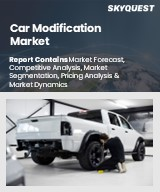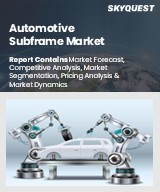
|
시장보고서
상품코드
1627988
자동차 서스펜션 시스템 시장 기회, 성장 촉진요인, 산업 동향 분석, 예측(2025-2034년)Automotive Suspension System Market Opportunity, Growth Drivers, Industry Trend Analysis, and Forecast 2025 to 2034 |
||||||
자동차 서스펜션 시스템 세계 시장은 2024년 466억 달러로 평가되며, 2025년부터 2034년까지 연평균 6.7% 성장할 것으로 전망됩니다.
시장을 주도하는 것은 세미 액티브 시스템과 액티브 시스템을 포함한 첨단 서스펜션 기술의 채택이 증가하고 있다는 점입니다. 이러한 시스템은 주행 상황에 자동으로 적응하여 승차감, 차량 핸들링 및 안전성을 향상시킵니다. 우수한 운전 경험을 원하는 소비자의 수요가 증가함에 따라 이러한 적응형 서스펜션 솔루션은 특히 고급차 및 고성능 차량에 대한 선호도가 높아지고 있습니다.
전자 제어 장치와 센서의 기술 발전으로 정확한 실시간 서스펜션 조정이 가능해짐에 따라 이러한 시스템은 미래 자동차 설계에 필수적인 요소로 자리 잡았습니다. 이러한 추세는 특히 전기자동차(EV)에서 두드러지게 나타나고 있으며, 고효율 부품에 대한 수요가 첨단 서스펜션 시스템의 통합을 가속화하고 있습니다.
서스펜션 제조에 있어 알루미늄, 탄소섬유, 첨단 복합재료와 같은 경량 소재의 사용이 증가하고 있는 것도 서스펜션 제조에 있어 큰 원동력이 되고 있습니다. 이러한 소재는 엄격한 배출가스 규제를 충족시키면서 연비와 성능을 향상시키는 데 필수적인 전체 차량 무게를 줄여주며, EV 분야에서 경량 서스펜션 솔루션은 배터리 효율과 주행거리를 극대화하는 데 필수적이기 때문에 자동차 제조업체의 수요가 증가하고 있습니다.
| 시장 범위 | |
|---|---|
| 시작 연도 | 2024 |
| 예측 연도 | 2025-2034 |
| 시작 금액 | 466억 달러 |
| 예상 금액 | 886억 달러 |
| CAGR | 6.7% |
시장은 판매 채널에 따라 OEM과 애프터마켓으로 구분되며, 2024년에는 OEM이 329억 달러 규모로 우위를 점할 것으로 예상되며, 향후에도 큰 점유율을 유지할 것으로 전망됩니다. 이러한 우위는 자동차의 안전, 편안함, 성능을 향상시키는 고품질의 독창적인 서스펜션 부품에 대한 선호에 기인합니다. 자동차 제조업체들은 제품을 차별화하고 진화하는 소비자의 기대에 부응하기 위해 OEM의 첨단 서스펜션 시스템에 대한 의존도를 높이고 있습니다.
차종별로는 승용차가 2024년 62%의 점유율을 차지할 것으로 예상되는데, 이는 편안함과 부드러운 주행 역동성을 추구하는 소비자 수요 증가에 기인합니다. 가처분 소득의 증가와 중형 및 고급차로의 전환은 적응형 및 멀티링크 구성을 포함한 자동차 서스펜션 시스템의 발전에 더욱 박차를 가하고 있습니다.
중국은 방대한 자동차 제조 기반과 전기 모빌리티의 급속한 보급에 힘입어 2024년 시장 수익의 35%를 차지했으며, 정부의 전기자동차 추진 노력과 국내 자동차 산업의 견조한 성장에 힘입어 첨단 저연비 서스펜션 기술에 대한 수요를 촉진하고 있습니다. 또한, 경량화 및 적응형 서스펜션 솔루션에 대한 광범위한 연구 개발로 인해 중국의 시장 입지가 강화되고 있습니다.
종합하면, 시장 성장은 기술 혁신, 경량 소재로의 전환, 우수한 차량 성능과 효율성에 대한 소비자 수요 증가에 의해 뒷받침되고 있습니다.
목차
제1장 조사 방법과 조사 범위
제2장 주요 요약
제3장 업계 인사이트
- 생태계 분석
- 공급업체 상황
- 원자재 공급업체
- 부품 공급업체
- 제조업체
- 서비스 프로바이더
- 판매업체
- 최종 용도
- 이익률 분석
- 비용 내역 분석
- 테크놀러지와 혁신 전망
- 주요 뉴스와 대처
- 규제 상황
- 영향요인
- 성장 촉진요인
- 내구성 향상을 위한 첨단 재료 채용
- 차량 안정성과 안전 기능에 대한 수요 증가
- 전기자동차 생산과 판매 확대
- 쾌적성과 운전 경험 중시
- 업계의 잠재적 리스크와 과제
- 첨단 서스펜션 시스템에 따른 고비용
- 전기자동차와 하이브리드 자동차 통합의 복잡성
- 성장 촉진요인
- 성장 가능성 분석
- Porters 분석
- PESTEL 분석
제4장 경쟁 구도
- 소개
- 기업 점유율 분석
- 경쟁 포지셔닝 매트릭스
- 전략 전망 매트릭스
제5장 시장 추정과 예측 : 시스템별, 2021-2034년
- 주요 동향
- 패시브
- 액티브
- 세미 액티브
제6장 시장 추정과 예측 : 차량별, 2021-2034년
- 주요 동향
- 승용차
- 해치백
- 세단
- SUV
- 상용차
- 소형 상용차(LCV)
- 대형 상용차(HCV)
제7장 시장 추정과 예측 : 구성요소별, 2021-2034년
- 주요 동향
- 쇼크 업소버
- 스프링
- 컨트롤 암
- 볼 조인트
- 에어 컴프레서
- 기타
제8장 시장 추정과 예측 : 서스펜션별, 2021-2034년
- 주요 동향
- 유압식
- 공기압식
- 전자식
제9장 시장 추정과 예측 : 판매 채널별, 2021-2034년
- 주요 동향
- OEM
- 애프터마켓
제10장 시장 추정과 예측 : 지역별, 2021-2034년
- 주요 동향
- 북미
- 미국
- 캐나다
- 유럽
- 영국
- 독일
- 프랑스
- 이탈리아
- 스페인
- 러시아
- 북유럽
- 아시아태평양
- 중국
- 인도
- 일본
- 한국
- 호주
- 동남아시아
- 라틴아메리카
- 브라질
- 아르헨티나
- 멕시코
- 중동 및 아프리카
- 아랍에미리트
- 사우디아라비아
- 남아프리카공화국
제11장 기업 개요
- Aisin
- Audi
- BMW
- Bosch
- BWI
- Continental
- Denso
- Ford
- Hitachi
- Hyundai Mobis
- KYB
- Magna
- Mando
- Marelli
- Mercedes
- Schaeffler
- Stellantis
- Tenneco
- Toyota
- ZF
The Global Automotive Suspension System Market reached USD 46.6 billion in 2024 and is projected to grow at a CAGR of 6.7% between 2025 and 2034. The market is driven by the rising adoption of advanced suspension technologies, including semi-active and active systems. These systems automatically adapt to driving conditions, enhancing ride comfort, vehicle handling, and safety. With growing consumer demand for superior driving experiences, these adaptive suspension solutions are gaining traction, particularly in luxury and high-performance vehicles.
Technological advancements in electronic control units and sensors are enabling precise and real-time suspension adjustments, making these systems an integral part of future automotive designs. This trend is particularly notable in electric vehicles (EVs), where the demand for high-efficiency components accelerates the integration of advanced suspension systems.
Another significant driver is the increased use of lightweight materials such as aluminum, carbon fiber, and advanced composites in suspension manufacturing. These materials reduce overall vehicle weight critical for improving fuel efficiency and performance while meeting stringent emissions regulations. In the EV sector, lightweight suspension solutions are essential for maximizing battery efficiency and range, boosting their demand among automakers.
| Market Scope | |
|---|---|
| Start Year | 2024 |
| Forecast Year | 2025-2034 |
| Start Value | $46.6 Billion |
| Forecast Value | $88.6 Billion |
| CAGR | 6.7% |
The market is segmented by sales channel into OEMs and aftermarkets. In 2024, OEMs dominated with a valuation of USD 32.9 billion and are expected to maintain a significant share. This dominance is attributed to the preference for high-quality, original suspension components that enhance vehicle safety, comfort, and performance. Automakers increasingly rely on advanced suspension systems from OEMs to differentiate their offerings and meet evolving consumer expectations.
By vehicle type, passenger cars accounted for a 62% share in 2024, driven by increasing consumer demand for enhanced comfort and smooth driving dynamics. Rising disposable incomes and a shift towards mid-to-premium vehicles have further fueled advancements in passenger car suspension systems, including adaptive and multi-link configurations.
China accounted for 35% of the market revenue in 2024, supported by its vast automotive manufacturing base and the rapid adoption of electric mobility. Government initiatives promoting EVs and robust domestic auto industry growth drive the demand for advanced, fuel-efficient suspension technologies. Additionally, extensive research and development in lightweight and adaptive suspension solutions bolsters the country's market position.
In summary, the market growth is underpinned by technological innovation, a shift towards lightweight materials, and increasing consumer demand for superior vehicle performance and efficiency.
Table of Contents
Chapter 1 Methodology & Scope
- 1.1 Research design
- 1.1.1 Research approach
- 1.1.2 Data collection methods
- 1.2 Base estimates and calculations
- 1.2.1 Base year calculation
- 1.2.2 Key trends for market estimates
- 1.3 Forecast model
- 1.4 Primary research & validation
- 1.4.1 Primary sources
- 1.4.2 Data mining sources
- 1.5 Market definitions
Chapter 2 Executive Summary
- 2.1 Industry 360° synopsis, 2021 - 2034
Chapter 3 Industry Insights
- 3.1 Industry ecosystem analysis
- 3.2 Supplier landscape
- 3.2.1 Raw material supplier
- 3.2.2 Component supplier
- 3.2.3 Manufacturer
- 3.2.4 Service provider
- 3.2.5 Distributor
- 3.2.6 End use
- 3.3 Profit margin analysis
- 3.4 Cost breakdown analysis
- 3.5 Technology & innovation landscape
- 3.6 Key news & initiatives
- 3.7 Regulatory landscape
- 3.8 Impact forces
- 3.8.1 Growth drivers
- 3.8.1.1 Adoption of advanced materials for improved durability
- 3.8.1.2 Increasing demand for vehicle stability and safety features
- 3.8.1.3 Expansion of electric vehicle production and sales
- 3.8.1.4 Greater emphasis on comfort and driving experience
- 3.8.2 Industry pitfalls & challenges
- 3.8.2.1 High costs associated with advanced suspension systems
- 3.8.2.2 Integration complexities in electric and hybrid vehicles
- 3.8.1 Growth drivers
- 3.9 Growth potential analysis
- 3.10 Porter's analysis
- 3.11 PESTEL analysis
Chapter 4 Competitive Landscape, 2024
- 4.1 Introduction
- 4.2 Company market share analysis
- 4.3 Competitive positioning matrix
- 4.4 Strategic outlook matrix
Chapter 5 Market Estimates & Forecast, By System, 2021 - 2034 ($Mn, Units)
- 5.1 Key trends
- 5.2 Passive
- 5.3 Active
- 5.4 Semi-active
Chapter 6 Market Estimates & Forecast, By Vehicle, 2021 - 2034 ($Mn, Units)
- 6.1 Key trends
- 6.2 Passenger cars
- 6.2.1 Hatchback
- 6.2.2 Sedan
- 6.2.3 SUV
- 6.3 Commercial vehicle
- 6.3.1 Light commercial vehicle (LCV)
- 6.3.2 Heavy commercial vehicle (HCV)
Chapter 7 Market Estimates & Forecast, By Component, 2021 - 2034 ($Mn, Units)
- 7.1 Key trends
- 7.2 Shock absorbers
- 7.3 Springs
- 7.4 Control arms
- 7.5 Ball joints
- 7.6 Air compressor
- 7.7 Others
Chapter 8 Market Estimates & Forecast, By Suspension, 2021 - 2034 ($Mn, Units)
- 8.1 Key trends
- 8.2 Hydraulic
- 8.3 Pneumatic
- 8.4 Electromagnetic
Chapter 9 Market Estimates & Forecast, By Sales Channel, 2021 - 2034 ($Mn, Units)
- 9.1 Key trends
- 9.2 OEM
- 9.3 Aftermarket
Chapter 10 Market Estimates & Forecast, By Region, 2021 - 2034 ($Mn, Units)
- 10.1 Key trends
- 10.2 North America
- 10.2.1 U.S.
- 10.2.2 Canada
- 10.3 Europe
- 10.3.1 UK
- 10.3.2 Germany
- 10.3.3 France
- 10.3.4 Italy
- 10.3.5 Spain
- 10.3.6 Russia
- 10.3.7 Nordics
- 10.4 Asia Pacific
- 10.4.1 China
- 10.4.2 India
- 10.4.3 Japan
- 10.4.4 South Korea
- 10.4.5 Australia
- 10.4.6 Southeast Asia
- 10.5 Latin America
- 10.5.1 Brazil
- 10.5.2 Argentina
- 10.5.3 Mexico
- 10.6 MEA
- 10.6.1 UAE
- 10.6.2 Saudi Arabia
- 10.6.3 South Africa
Chapter 11 Company Profiles
- 11.1 Aisin
- 11.2 Audi
- 11.3 BMW
- 11.4 Bosch
- 11.5 BWI
- 11.6 Continental
- 11.7 Denso
- 11.8 Ford
- 11.9 Hitachi
- 11.10 Hyundai Mobis
- 11.11 KYB
- 11.12 Magna
- 11.13 Mando
- 11.14 Marelli
- 11.15 Mercedes
- 11.16 Schaeffler
- 11.17 Stellantis
- 11.18 Tenneco
- 11.19 Toyota
- 11.20 ZF



















